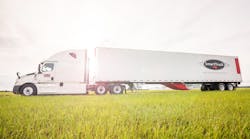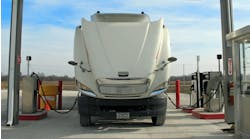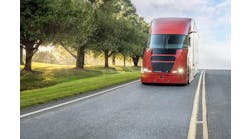As U.S. EPA emission standards become more stringent and fleets are pressured to become increasingly more fuel efficient, trailer aerodynamic devices can offer a solution to improve overall vehicle efficiency.
“Aerodynamics matter,” says Steve Ingham, CEO of trailer aerodynamic supplier SmartTruck. “The aerodynamics of the tractor-trailer system has a direct effect on the overall performance and operational efficiency of the system.”
As a truck and trailer drives down the highway, it encounters resistance, or drag, from the air flowing at and around it. Oncoming air flow on the front of the tractor creates a high pressure area. This creates three main areas of drag on the trailer: the front of the trailer at the top, by the trailer gap; the undercarriage of the trailer; and the back of the trailer by the doors. These areas of drag create resistance that pulls the vehicle backwards as it is trying to move forwards, increasing strain on the engine and drivetrain, says Drake Piper, category director for ITMS at STEMCO. STEMCO is the supplier of a diverse line of high performance systems and components to the commercial vehicle industry. The Innovative Tire and Mileage Solutions (ITMS) division of STEMCO provides solutions to increase fuel efficiency, reduce maintenance costs and increase roadway safety.
Trailer aerodynamic solutions work by decreasing aerodynamic drag on the trailer, which in turn reduces strain on the engine, helping to improve fuel economy and operational efficiency.
Types of aerodynamic solutions
Trailer aerodynamic solutions are not a one-size-fits-all purchase. The types of devices that make sense for a fleet will depend largely on application, vehicle type, the type of terrain the vehicle drives on and more. In many cases, these solutions are customizable to fit the use of the tractor and trailer.
“[For example,] we have one component that’s fundamentally focused on dry vans,” says SmartTruck’s Ingham. “It can’t be put on a refrigerated trailer because of the refrigerated unit on the front. With different types of personalized features on trailers, we are able to customize aerodynamic solutions around that.”
Other factors to consider are whether the device will work with the trailer specs, including length and height, and with work performance devices such as liftgates, ramp operations and different types of doors, adds Chris Lee, vice president of engineering for Great Dane. Great Dane is a manufacturer of truck dry van, refrigerated van and flatbed semi-trailers.
Here is a basic overview of each of the basic trailer aerodynamic devices, and which area of drag they help to reduce:
- Side skirts. Help reduce aerodynamic drag under the trailer where air hits the trailer’s rear axles. These devices help guide air around the sides and to the back of the trailer.
- Trailer tails. Help minimize the low-pressure vacuum that occurs directly behind the trailer. This is typically the area that creates the largest amount of drag, so improving the aerodynamics of this part of the trailer can help improve vehicle stability and fuel efficiency.
- Nose fairings and gap reducers. Designed to fill the area between the tractor and the front of a dry trailer, helping to shield from crosswinds and reduce drag on the front of the trailer.
- Wheel covers and mudflaps. Help reduce turbulence and drag around the wheels, which helps improve fuel efficiency.
Often, different types of aerodynamic devices will complement each other. For instance, a fleet may choose to use a trailer tail and a side skirt to address both undercarriage drag and drag at the rear of the trailer. Employing one aerodynamic device does not preclude a fleet from installing another.
Fleets have the option of installing aerodynamic solutions piecemeal, or selecting an aerodynamic trailer solution kit.
“Michelin offers a kit for use on 53’ dry-van truck load, refrigerated truck load and other long haul and super regional applications,” notes Calvin Bradley, aerodynamics technical lead for Michelin North America. “This integrated kit eliminates the need to combine elements from various vendors. Solutions put together from different parts that someone combines may not necessarily work together, and therefore, may not deliver the expected results.”
While known for tires in nearly every tire market, Michelin North America also manufactures aerodynamic devices. The company recently introduced an aerodynamic trailer kit at the Technology & Maintenance Council’s Annual Meeting earlier this year.
“Kits are only successful to the extent that it makes sense for the fleet to buy all of the components of the kit together,” adds Josh Butler, president of vehicle aerodynamics device provider FlowBelow. “For example, if the kit is validated to provide a certain fuel economy, and the components of the kit are designed to work well together.” When a kit is proven to work for the fleet’s application, it takes the guesswork out of deciding which aerodynamic options from which manufacturers are going to work well together to achieve the desired efficiencies. These all-inclusive kits can simplify the buying process.
On the other hand, aerodynamic kits do not offer the same degree of customization that selecting solutions individually might offer.
“When selecting aerodynamic devices for trailers, fleets should work closely with aero device suppliers and trailer OEMs to get the most effective solutions for their operations,” Lee suggests. “One-size-fits-all approaches will not work [as effectively].”
To ensure they select appropriate aerodynamic devices for their equipment and operational needs, fleets should consider discussing their options with the OEM and the device provider. They will be able to help determine whether a kit or a more customized approach is appropriate for the fleet’s unique operation.
What to look for in an effective aerodynamic solution
Improving fuel efficiency and overall vehicle efficiency is a worthy goal, but fleets also need to consider whether a particular device will offer a good return on investment. Ideally, fleets should be able to see a return on their aerodynamic investments within two years or less, says FlowBelow’s Butler.
He suggests looking for the following qualities when selecting aerodynamic devices:
- Durability/life expectancy - How does the equipment perform in extreme conditions and over time?
- Compatibility - Is the product compatible with other aero products already employed?
- Functionality - Will the equipment function reliably?
- Support - Does the company offer customer support? Can they support the product in the field?
- Driver interaction - Does the equipment function all the time, or does the driver need to deploy?
- Maintenance - How much money and time does it cost to maintain the product, and can it be easily maintained in-house? Are replacement parts readily available?
- Aesthetics - How does the product impact the company brand identity or the look of the fleet?
“Look for real return on investment testing by third party test verification,” adds STEMCO’s Piper. “[The company] should be able to stand behind their product with a strong warranty, in-field support and proven product life cycle.”
Consider how the device was developed and tested, what the components are made of and what the company’s research and development process looks like. If they claim to improve fuel efficiency by a certain percent, what kind of testing did they use to determine that efficiency? Is it backed by customer tests to validate the performance? Generally, the more thorough the company’s testing process is, the more certain the fleet can be that the product will work as expected.
Also consider the amount of maintenance the device will require, the added weight of the device and whether those compare to the benefits to get an idea of what the total cost of ownership will be. “Aerodynamic solutions should cut fuel costs without increasing maintenance costs or requiring driver attention or costly repairs,” Michelin’s Bradley says.
SmartTruck’s Ingham adds that fleets need to consider what aerodynamic solutions they have already employed, and whether a new device would add to that benefit. “There is a practical limit,” Ingham says. “You can’t improve the same aerodynamic problem twice. So, fleets need to be smart about how they can be as efficient as possible.”
Installation options
Fleets have three options when it comes to installing aerodynamic devices: they can spec them as part of a new trailer order, retrofit in their own shop or have the aero device provider professionally install.
“Normally, aerodynamic device installation is done by trailer OEMs, branches or dealers,” Great Dane’s Lee says. “Third party installation through repair shops or subcontractors is also an option.”
For fleets that elect to install in their own facilities, most aerodynamic device manufacturers offer support materials and detailed instructions for installation. “[Our system] can be installed in under an hour by either the fleet’s maintenance/service crews, or by their trailer dealer,” FlowBelow’s Butler says.
But, SmartTruck’s Ingham adds that in most cases, fleets decide to spec aerodynamic devices with the purchase of a new trailer, so it makes the most sense for the trailer OEM to install the device. “One of the trigger mechanisms for making decisions about aerodynamics is the purchase of a new trailer,” Ingham explains. “All of our devices can be installed online when the trailer is manufactured, so there is no extra effort required on the part of the purchaser when it’s associated with a new trailer purchase.”
Fleets also have the option to work with a third-party installation professional that has been trained by the aerodynamic device provider. Manufacturers may offer a network of providers who are able to install aerodynamic devices for fleets who are adding them to trailers they already have.
Aerodynamic device maintenance
Aerodynamic devices should be inspected at regular intervals to ensure that everything is functioning properly and there is no visible damage.
“We recommend that everything is looked at during all scheduled intervals or service,” says STEMCO’s Piper. “Our history shows less than $30 a year in parts average during the life of the product.”
“Regularly scheduled maintenance is recommended per the aerodynamic device supplier’s recommendation,” adds Great Dane’s Lee.
During inspections, fleets should check for structural damage and signs of wear and tear. Also check bolts and brackets to ensure that everything has remained tight during use. Any safety concerns should be addressed during maintenance.
The future of aerodynamics
Improving truck and trailer aerodynamics is not a new concept, but the industry is just starting to see an increased adoption of these devices. Much of that initial adoption was mandated by government regulations. The U.S. EPA Greenhouse Gas Phase 2 regulations included aerodynamics as part of its rulemaking, and in 2008, the California Air Resources Board mandated the use of SmartWay-certified tractors and trailers driven in the state of California. Regulations such as these have driven the initial investment in trailer aerodynamics. As these regulations continue to dictate that fleets become increasingly efficient, aerodynamic devices are an option for fleets to meet these efficiency standards.
“There have been and still are in place regulations that require some level of aerodynamics,” SmartTruck’s Ingham says. “Let’s say, for example, that a fleet put skirts on their trailer so they can be compliant and go into and out of California. They will notice a modest improvement in fuel economy as part of that, and will be more open to other aerodynamic devices moving forward.”
While adoption of aerodynamic devices was mandated by regulations initially, SmartTruck anticipates that future adoption will be driven by a desire to improve efficiency, because the initial devices helped improve fuel efficiency.
“We foresee a trend of trailer manufacturers providing complete aerodynamic devices as an option at build,” adds STEMCO’s Piper.
This trend will be compounded as the industry explores alternative fuel sources such as electric vehicles, which are currently limited by their range between charges. Improving overall vehicle efficiency can help extend the range a vehicle can travel on the same amount of fuel. “That fuel in an electric truck is juice out of the battery,” Ingham explains. “One of the ways you manage the size of the battery is to make sure that the tractor trailer system is as aerodynamic as possible.”
“[Another] trend in trailer aero products is toward eliminating driver involvement,” FlowBelow’s Butler says. Drivers have enough to worry about already, without needing to deploy aerodynamic devices at highway speeds and monitor that those (devices) are operating correctly. Aerodynamic device manufacturers are working towards developing low-maintenance devices that don’t require driver input.
“Fleets should expect to see more robust and efficient aero devices on trailers with little-to-no maintenance in the future,” Great Dane’s Lee adds.
Aerodynamics offers a solution to the efficiency challenges that fleets are currently facing. The economy is dependent on the trucking industry, and the structure of the industry isn’t likely to change anytime soon, Ingham says. So, the question becomes, how can trucks and trailers be as efficient as possible, while still offering a good return on investment?
“The point is, aerodynamics matter, and they’re going to continue to matter for a long time,” Ingham concludes.




